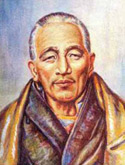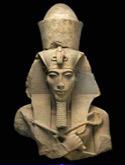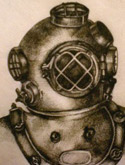As many of you are aware, for some years I have been researching the history of the search for the planet Vulcan. The search has been an integral part of astronomical history, especially during the latter part of the 19th century. I will summarize the history into a very short space here.
Speculation about the existence of an intra-mercurial planet is not new – it existed going back to the days of Galileo. It was not until the discoverer of Neptune, Urban LeVerrier examined the movements of the planet Mercury in 1859 that there was a valid astronomical reason for the existence of Vulcan – the motion of Mercury was off by a hair, and the only reasonable explanation of the motion was a planet inside the orbit of Mercury. Almost immediately, a French doctor, Edmund Lescarbault, wrote LeVerrier that he had seen such a planet transiting the Sun a few months earlier. An orbit was calculated, and the search was on.
Prior astronomical sightings were examined as well, and several potential sightings were found. However, for the most part, Vulcan was nowhere to be seen except possibly at the eclipse of July 29, 1878.
By the early 1900’s, the search had basically been given up, and in 1915 Albert Einstein found the solution to the movement of Mercury with his Theory of Relativity. In recent years though, three astronomers have given good sound reasoning for asteroids to be found within the orbit of Mercury, and the data from the SOHO satellite which is examining the Sun for other reasons will be used to potentially find these objects, one of which will be what we know as Vulcan.
I have been asked many times – is Vulcan an etheric or physical planet, and it is the intention of this article to examine this issue carefully, looking at the words of D.K. to help us in this search. It is my belief that Vulcan is a dense, physical planet, whose orbit is between Mercury and the Sun, and may have already been discovered!
An examination of A Treatise on Cosmic Fire (Alice Bailey, Lucis Trust, New York, 1925.) which was published before the discovery of Pluto reveals the following:
1. Pluto is not mentioned at all in TCF, which is consistent with it not having been discovered at the time of the publication of TCF. (This was done using the CD-ROM of all the Bailey books.)
2. Vulcan is mentioned, and there is the statement that “Vulcan is within the orbit of Mercury”1.
Vulcan is also mentioned in several other places in TCF, but none of them have to do with the matter at hand. Vulcan is also mentioned in several of the other books on the Seven Rays, but it is in Esoteric Astrology (Alice Bailey, Lucis Trust, New York, 1951.) that there is material which can provide some clues.
1. Pluto is mentioned which is consistent with its discovery in 1930, some twenty years earlier than the publication date of EA.
2. Vulcan again is mentioned, and there are some thoughts about its discovery:
3. “Hence the recent discovery of Pluto and the sensed power of Vulcan (My emphasis.), veiled by the potency of Mercury and hidden behind the planet”2.
4. “Vulcan and Pluto are expressions or custodians of this first ray energy and are, as I have told you, esoteric planets. The first indication of the true spiritual will only begins to manifest upon the Path of Discipleship – hence the late discovery of these two planets (My emphasis.) (late in point of time and from the angle of human knowledge) for it is only in this Aryan race period that humanity is to any large extent beginning to manifest evidence (and as yet it is no more) of a reaction or a response to the spiritual will of deity as it comes to our planet and hence to us via Aries, Vulcan and Pluto”3.
So, it is implied that Vulcan has been discovered, although not officially. D.K.’s thoughts are somewhat curious, and may appear to be contradictory. The “sensed power” and “the late discovery of these two planets” are in fact though not so contradictory. What I feel is meant by the “sensed power” is that D.K. is acknowledging on one level that Vulcan has not been “officially” discovered and an orbit computed for it. Yet since 1859 Vulcan has been on the conscious “minds” of humanity (the planet that Lescarbault saw in 1859 “saw” was given the name Vulcan). The reference to Mercury is somewhat curious, as the search for Vulcan was born out of a problem with Mercury’s orbit. LeVerrier when he first wrote about the computation of Mercury’s orbit that “No planet has extracted more pain and trouble of the astronomers than Mercury, and has rewarded them with so much anxiety and given them so many obstacles”4 – a very classic 4th Ray statement!
Hidden behind that planet could mean many things. The most obvious is that the orbit of Vulcan is such that it could have a synchronicity with that of Mercury and would be physically hidden behind Mercury at the same points in their orbits, but without an orbit for Vulcan, that is only speculation. Pluto was discovered in 1930, and yet the search for it started shortly after the discovery of Neptune, and Pluto was actually photographed sometime in 1910’s. The statement that the discovery of Pluto and Vulcan was late from the standpoint of humanity means that the energy of both these planets was known on the subconscious level, and it is only been recently that humanity has evolved enough to both be ready to use and consciously avail ourselves of the energy of these planets5.
Since Vulcan is mentioned in TCF, there is an implication that it had been discovered by the time TCF was published in 1925. The statement that Vulcan is within the orbit of Mercury is somewhat loose in that it is not per se stated that Vulcan is an intra-Mercurial planet. There are some asteroids whose perihelion point is inside that of Mercury – the first and best known of these is Icarus – and one of these asteroids could possibly be what he means. However, Icarus was discovered in 1949 and that is after the publication of TCF. It is reasonable to assume for that reason that we are talking about an intra-Mercurial planet.
For the reasons enumerated above, it would seem that Vulcan is a dense physical planet, for while D.K. has stated that there are many planets in the solar system, the only ones that he talks about are on the dense physical plane – which makes sense, for the majority of humanity at this time can only respond and react to the planets on this plane.
So, if Vulcan is on the physical plane and already has been discovered, then the question arises – when was Vulcan discovered? Fortunately, there are some clues that can be of help from the discovery charts of Uranus, Neptune, and Pluto. The dates and times of the discovery of these planets is in Table 1, and are accurate – I was able to find a definitive time for the discovery of Neptune and the time of Uranus is derived from a close examination of William Herschel’s log of the date of discovery.
There are two major common themes in the three charts. One is that the Moon is in Scorpio, and the other one is that Saturn is opposite Uranus, conjunct Neptune, and widely opposite and contra-parallel Pluto, which has the effect of an opposition. That makes sense, for Saturn is the other planet on Ray 3, and its being in aspect with the planet being discovered permits the knowledge and the energy of the planet to be detected on the Earth. It should be obvious that the Ray of the planet being discovered is being activated on the Earth plane is some manner; however, after much testing and looking at the charts, how it happens is not obvious.
An examination of some of the dates that Vulcan was supposedly discovered was done – the group that was examined was the group of dates that LeVerrier and other astronomers felt were more plausible than the rest of them, and these observations appear in Table 2, along with the position of the Moon and the aspect of Saturn to the Sun – since these observations were of transits of Vulcan to the Sun, then if Saturn aspects the Sun, it will also aspect Vulcan.
There is one observation that fits both criteria – that of Joseph Sidebottham who saw an object transiting the Sun on March 12, 1849 at 4:00PM and the astrological positions are given in Chart 1. Vulcan is exactly conjunct the Sun.
As a very quick aside, D.K. makes mention of two more planets in the solar system. The references are as follows:
- “Some day they will arrive at a clear decision as to the position of the five planets suggested as ruling the decanates (they agree on one); I cannot indicate to you the essential truth because a new planet is arising in this sign and it is for man to discover and rightly place it within the circumference of the Great Wheel”6 .
- “Beyond these two distant planets, lies another planet as yet undiscovered, though speculation is rife about it, owing yo certain unexplained movements of the planet Neptune. It is through this planet that the Forces (as they are related to Leo and Aquarius) are focussed in one potent stream of force; these pour into our planetary life during the month of August, and distribute themselves, via Uranus and Neptune. You have, therefore, in this connection:
LEO AND AQUARIUS
/
The physical Sun…… Heart of the Sun……. Central spiritual Sun.
/
The undiscovered planet.
/
Uranus and Neptune.
/
The human Hierarchy.
/
The animal Kingdom.
Charts of the cosmic lines of directed forces such as the above can be given for all the energies of the constellations and planetary forces, but this is the only one I choose, at this time, to indicate, because it is of major importance to humanity; the others might prove misleading, given man’s present point of intelligent understanding and influence”7.
It is not known which of these planets would be the planet that is “missing” from Ray 5 or from Ray 7 – that will have to be determined when the planet is discovered. It should be remembered that these two planets are acting at the subconscious level. Again, it can argued reasonably that these are dense physical planets rather than at a higher level since that are mentioned as going to be discovered. It might be noted that there are potentially two more planets to be discovered, as is well known, the Sun and Moon are said to veil planets.
I hope that this short article will give you a sense of why I feel that Vulcan is a dense physical planet, and if D.K. is correct, that it has been already discovered. The hope is that Vulcan can be found by the astronomers shortly. The real questions are to 1) find the discovery date and 2) a reliable orbit8 that can be found so that the awesome power of Vulcan can be made completely overt and allow all of us to use its energy to fashion the Plan.
Table 1
| Planet | Date | Time | Place | Time Zone | Longitude | Latitude |
| Uranus | March 13, 1781 | 10:30 PM | Bath, England | LMT | 2 W 20 | 51 N 23 |
| Neptune | September 24, 1846 | 00:14.6 AM | Berlin, Germany | LMT | 13 E 22 | 52 N 29 |
| Pluto | February 18, 1930 | 4:00 PM | Flagstaff, AZ | PST | 111 W 39 | 35 N 12 |
| Vulcan? | March 12, 1849 | 4:00 PM | Manchester, England | LMT | 2 W 15 | 53 N 30 |
Table 2
| 1. | Fritsch | 10/02/1802 |
| 2. | Lofft | 1/6/1818 |
| 3. | DeCuppis | 10/2/1839 |
| 4. | Sidebotham | 3/12/1849 |
| 5. | Lummis | 3/20/1862 |
References
- A Treatise on Cosmic Fire, op cit, p. 206, footnote. [↩]
- Esoteric Astrology, op cit, p. 166. [↩]
- Esoteric Astrology, op cit, p. 195. [↩]
- Comptes Rendus de l’Academie des Sciences,16:1054,1843. [↩]
- It is curious to note that L.H. Weston noted in his pamphlet that the Atlanteans were aware of Vulcan, and that in Taylor Caldwell’s Romance of Atlantis there is a recounting of the discovery of Vulcan in Atlantis! [↩]
- Esoteric Astrology, op cit, p. 226. The sign under discussion is Scorpio. [↩]
- Esoteric Astrology, op cit, p. 308. The sign under discussion is Aquarius. [↩]
- Both the Weston/Stahl and the Baker orbits are invalid for reasons too complex to mention here. Basically, there are problems with the celestial mechanics of both of them. [↩]















Thank you for this article
On the orbit of Vulcan you mention that the two most widely used options for Vulcans orbit are incorrectly?… But do not put forward an alternative?
Do you have one at all?
S
I have long been interested in the subject of Vulcan. Over the course of the past month or so, I have inserted the positions of 1,415 asteroids, including 125 Mercury-crossing minor planets, into 20 event charts for alleged transits of Vulcan. There is now little doubt in my mind that Vulcan — or, at least, the object which it was presumed to be — is none other than 5143 Heracles, associated with the β–Taurids meteor shower (named after their radiant point in the constellation Taurus), precovered first in 1953 and second in 1991.
It is my understanding that Vulcan is not an asteroid, and is an intra-Mercurial planet, obscured for the most part by the sun and the amount of light that Mercury reflects. David Walters in his book on Vulcan makes a strong argument for this.